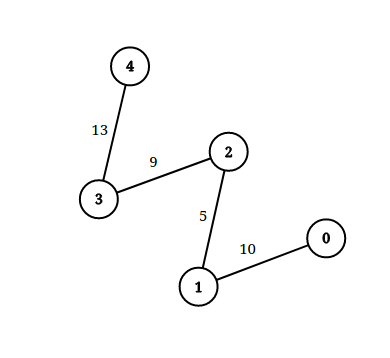An undirected graph of n nodes is defined by edgeList, where edgeList[i] = [ui, vi, disi] denotes an edge between nodes ui and vi with distance disi. Note that there may be multiple edges between two nodes.
Given an array queries, where queries[j] = [pj, qj, limitj], your task is to determine for each queries[j] whether there is a path between pj and qj such that each edge on the path has a distance strictly less than limitj .
Return a boolean array answer, where answer.length == queries.length and the jth value of answer is true if there is a path for queries[j] is true, and false otherwise.
Example 1:
Input: n = 3, edgeList = [[0,1,2],[1,2,4],[2,0,8],[1,0,16]], queries = [[0,1,2],[0,2,5]] Output: [false,true] Explanation: The above figure shows the given graph. Note that there are two overlapping edges between 0 and 1 with distances 2 and 16. For the first query, between 0 and 1 there is no path where each distance is less than 2, thus we return false for this query. For the second query, there is a path (0 -> 1 -> 2) of two edges with distances less than 5, thus we return true for this query.
Example 2:
Input: n = 5, edgeList = [[0,1,10],[1,2,5],[2,3,9],[3,4,13]], queries = [[0,4,14],[1,4,13]] Output: [true,false] Explanation: The above figure shows the given graph.
Constraints:
2 <= n <= 1051 <= edgeList.length, queries.length <= 105edgeList[i].length == 3queries[j].length == 30 <= ui, vi, pj, qj <= n - 1ui != vipj != qj1 <= disi, limitj <= 109- There may be multiple edges between two nodes.
Union find.
class Solution:
def distanceLimitedPathsExist(self, n: int, edgeList: List[List[int]], queries: List[List[int]]) -> List[bool]:
def find(x):
if p[x] != x:
p[x] = find(p[x])
return p[x]
p = list(range(n))
edgeList.sort(key=lambda x: x[2])
j = 0
ans = [False] * len(queries)
for i, (a, b, limit) in sorted(enumerate(queries), key=lambda x: x[1][2]):
while j < len(edgeList) and edgeList[j][2] < limit:
u, v, _ = edgeList[j]
p[find(u)] = find(v)
j += 1
ans[i] = find(a) == find(b)
return ansclass Solution {
private int[] p;
public boolean[] distanceLimitedPathsExist(int n, int[][] edgeList, int[][] queries) {
p = new int[n];
for (int i = 0; i < n; ++i) {
p[i] = i;
}
Arrays.sort(edgeList, (a, b) -> a[2] - b[2]);
int m = queries.length;
boolean[] ans = new boolean[m];
Integer[] qid = new Integer[m];
for (int i = 0; i < m; ++i) {
qid[i] = i;
}
Arrays.sort(qid, (i, j) -> queries[i][2] - queries[j][2]);
int j = 0;
for (int i : qid) {
int a = queries[i][0], b = queries[i][1], limit = queries[i][2];
while (j < edgeList.length && edgeList[j][2] < limit) {
int u = edgeList[j][0], v = edgeList[j][1];
p[find(u)] = find(v);
++j;
}
ans[i] = find(a) == find(b);
}
return ans;
}
private int find(int x) {
if (p[x] != x) {
p[x] = find(p[x]);
}
return p[x];
}
}class Solution {
public:
vector<bool> distanceLimitedPathsExist(int n, vector<vector<int>>& edgeList, vector<vector<int>>& queries) {
vector<int> p(n);
iota(p.begin(), p.end(), 0);
sort(edgeList.begin(), edgeList.end(), [](auto& a, auto& b) { return a[2] < b[2]; });
function<int(int)> find = [&](int x) -> int {
if (p[x] != x) p[x] = find(p[x]);
return p[x];
};
int m = queries.size();
vector<bool> ans(m);
vector<int> qid(m);
iota(qid.begin(), qid.end(), 0);
sort(qid.begin(), qid.end(), [&](int i, int j) { return queries[i][2] < queries[j][2]; });
int j = 0;
for (int i : qid) {
int a = queries[i][0], b = queries[i][1], limit = queries[i][2];
while (j < edgeList.size() && edgeList[j][2] < limit) {
int u = edgeList[j][0], v = edgeList[j][1];
p[find(u)] = find(v);
++j;
}
ans[i] = find(a) == find(b);
}
return ans;
}
};func distanceLimitedPathsExist(n int, edgeList [][]int, queries [][]int) []bool {
p := make([]int, n)
for i := range p {
p[i] = i
}
sort.Slice(edgeList, func(i, j int) bool { return edgeList[i][2] < edgeList[j][2] })
var find func(int) int
find = func(x int) int {
if p[x] != x {
p[x] = find(p[x])
}
return p[x]
}
m := len(queries)
qid := make([]int, m)
ans := make([]bool, m)
for i := range qid {
qid[i] = i
}
sort.Slice(qid, func(i, j int) bool { return queries[qid[i]][2] < queries[qid[j]][2] })
j := 0
for _, i := range qid {
a, b, limit := queries[i][0], queries[i][1], queries[i][2]
for j < len(edgeList) && edgeList[j][2] < limit {
u, v := edgeList[j][0], edgeList[j][1]
p[find(u)] = find(v)
j++
}
ans[i] = find(a) == find(b)
}
return ans
}

